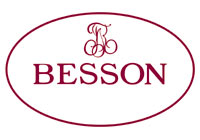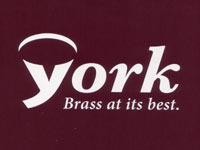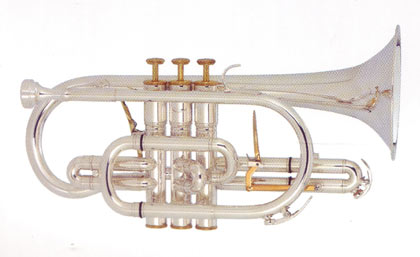The Brass identity game - The Besson and York fight
30-Jan-2007Besson and York are set to battle it out at the top end of the brass instrument market place - and it may prove to be something of a bloody fight with accusations and rumours flying around like mispitched semi quavers.
2007 could well be the year in which brass band contesting battles take a back seat to a battle royal between the instruments makers that provide the bands with the tools of their trade.
With the demise of Besson Musical Instruments the void in instrument manufacture has been filled by a number of new and existing manufacturers, and whilst competition may mean good news for the consumer, it may also mean good news for lawyers too.
 The background to the possible potentially damaging and expensive legal outcomes can be traced directly back to the end of Besson Musical Instruments in 2006. Eventually bought by the Buffet Crampon Group, the purchase was announced with confidence by the President of Buffet Paul Baronnat in January 2006 with the words: "We are delighted to welcome the Besson Group into the group…" Crucially he went on to add: "As part of the acquisition agreement, Buffet Crampon acquires the existing finished goods inventory of Besson…"
The background to the possible potentially damaging and expensive legal outcomes can be traced directly back to the end of Besson Musical Instruments in 2006. Eventually bought by the Buffet Crampon Group, the purchase was announced with confidence by the President of Buffet Paul Baronnat in January 2006 with the words: "We are delighted to welcome the Besson Group into the group…" Crucially he went on to add: "As part of the acquisition agreement, Buffet Crampon acquires the existing finished goods inventory of Besson…"
Fast forward 12 months and at a very plush launch night in Frankfurt in Germany and Schreiber Keilwerth launched their new range of York instruments into the market place, whilst in the interim there has also been launches for London Musical Instruments, Virtuosi and Yamaha amongst others too. Never has the market place been so awash with instruments to satisfy the demands and the pockets of customers from learner to world-class level.
 It is the quality end of the market place however that could well see a battle of giants not only on the contest stages around Europe, but possibly in the courtrooms too. As ever with such goings on there are rumours and counter rumours, whispers and stories, some confirmed and some from sources within the differing camps.
It is the quality end of the market place however that could well see a battle of giants not only on the contest stages around Europe, but possibly in the courtrooms too. As ever with such goings on there are rumours and counter rumours, whispers and stories, some confirmed and some from sources within the differing camps.
It seems it may be all about a question of the ownership of identity (or intellectual property as it is more commonly referred to by the lawyers) – one of the most tricky legalistic questions to be answered between two major players in particular who are battling it out for what they see is their rightful share of a brass instrument market that is believed to be around £9 million a year in Europe and the UK.
The players
Those two players are Buffet Crampon and their Besson brand and Schreiber Keilwerth and their York range.
With the Besson demise it was made apparent that Buffet Crampon had purchased certain assets of the former company, but it was also revealed that the company responsible for manufacturing Besson instruments was Schreiber Keilwerth, which crucially remained within the Music Group, the main shareholders of which are Rutland Partners LLP that sold the Besson brand to Buffet Crampon. The grey area seems to have been about the designs and blueprints of the instruments themselves – although either party believes they have acted correctly to protect their interests.
With Schreiber already possessing the requisite manufacturing components and tooling they took the decision to manufacture their own range of instruments – the York Brand from their base in Markneukirchen, whilst Buffet Crampon headed literally a few hundred meters to their manufacturing base in the same town to start its production of its Besson range once more.
Rumours
That it seems is all well and good, but rumours have been flying around the all important dealers that not all is as it seems, especially when it comes to the instruments themselves.
As one leading dealer told 4BR: "It's a bit like producing cars. Basically they are all the same – 4 wheels, engine, steering wheel and seats. It just the stuff that surrounds them that is, and should be, different."
What that difference is in respect to Besson and York seems to be the crux of the problem though, with reputed allegations of industrial plagiarism, copycat design and cosmetic surgery. Both camps are clear and unequivocal in their own mind about where they stand though, even though both undoubtedly share a common lineage connection back to the former Besson Musical Instruments.
 The personnel involved in both camps can trace its ancestry back too: The new Besson instruments have the likes of Roger Webster and Steven Mead very much on board whilst the former production manager Werner Duwe heads operations. York meanwhile include John Rogers and Alan Hughes, the former MD and International Market Director of Besson on their side as well as performers such as David Childs and Alan Morrison – both former Besson endorsees.
The personnel involved in both camps can trace its ancestry back too: The new Besson instruments have the likes of Roger Webster and Steven Mead very much on board whilst the former production manager Werner Duwe heads operations. York meanwhile include John Rogers and Alan Hughes, the former MD and International Market Director of Besson on their side as well as performers such as David Childs and Alan Morrison – both former Besson endorsees.
One leading supporter of the Besson told 4BR that it was a pity that this problem has arisen, as there seems to be room in the market place for both brands – if they were to be substantially different from each other in characteristic to offer performers a realistic choice.
"No one would have a problem with anybody coming into the business with their own designs for instruments and trying to grab their share of the market, but there are serious questions to be asked about whether or not some instruments we are now seeing from certain competitors are new designs or just rehashes of what Besson produced – especially in regard to the old Prestige and Sovereign ranges."
 One dealer seemed to pin point it clearly. "The feeling is that out of the mess that was Besson has come two manufacturers that are now using all that was good about the former Sovereign and Prestige, getting rid of the problems that were associated with quality and putting their own name to them. You can see where the basic design has come from and you can see the changes that have been made – but you have to wonder if these really are brand new instruments as they are claimed to be or upgrades of previous incarnations."
One dealer seemed to pin point it clearly. "The feeling is that out of the mess that was Besson has come two manufacturers that are now using all that was good about the former Sovereign and Prestige, getting rid of the problems that were associated with quality and putting their own name to them. You can see where the basic design has come from and you can see the changes that have been made – but you have to wonder if these really are brand new instruments as they are claimed to be or upgrades of previous incarnations."
Stolen a march
York has clearly stolen something of a march with the launch of their range at Frankfurt, where the range of their ‘Preference' and ‘Eminence' instruments was greeted with enthusiasm and acknowledgment from the hard core of the usually cynical dealers whose job it is to sell the instruments to the general public. As one dealer told 4BR at the launch, "They look and feel very good indeed – but the acid test is whether or not that level of quality can be maintained in 6 – 12 months time when we are in need of instruments to meet demand. That is where Besson fell down badly in years gone by – the quality was at times pretty rubbish and we felt the backlash of it from our customers. If they can get that right them these instruments will definitely sell and sell well."
Are they different though?

The York Eminence cornet
As one dealer at Frankfurt told us: "Yes. There appears to be plenty of work done on them, with new features and designs, some integral to the structure of the instrument, some not. The company makes it pretty clear of where the heritage and tradition of instruments lies. They had the tooling to produce instruments under their own name and they seem clear in their own minds that they are just that."
Meanwhile a separate dealer at the Royal Northern College of Music Festival of Brass told 4BR abut the new Besson range: "The new Besson instruments that we have taken stock of are excellent quality and a vast improvement on the old range that suffered too many quality problems. There are major changes to the structure of the instruments as well as some cosmetic ones too. It certainly looks the part, and we have been assured that the quality of production will be maintained even when demand is high."
 New instruments?
New instruments?
So are we seeing new instruments from either camps or just improvements on a well loved, but flawed production process of the originals?
One source with more knowledge than most seemed to think that it may be a question of knowing how to make the most of some loopholes that should have been closed prior to the sale of Besson. "There are all sorts of rumours flying around of instruments that are exactly the same but stamped with a name brand name on them, others that the serial numbers seem to be in line with what has been produced previously, alleged production delays and even that old parts are being used on new instruments - but it seems to be very hard to prove either way."
Others though are more forthright, as a different source told 4BR: "These are essentially the same instruments given a quality control make over. Just look at the specifications on both the York and the Besson - bore size, bell diameter, weight etc and what do you see? There is nothing illegal or morally wrong as far as I can see what either makers are doing – both are cleverly exploiting the situation even though neither are happy with each other at the way in which they have gone about it. I doubt that anything will come of the dispute as there is still a strong business link between Besson and Schreiber in the woodwind market and both know that with the exception of Yamaha, they can out muscle just about any other brands in the quality sector of the market place."
Final outcome
That may well be the final outcome, but in the meantime the wrangling hasn't stopped with reports of threats of possible legal action and more industry gossip and rumour set to be aired before the matter is finally put to rest. As that one rather cynical dealer told us: "York has stolen a march on Besson for sure, but Besson will come back strongly now that they are in full production. You can forget the designs and the squabbles, either of them will fail if they cannot maintain their quality – whatever they look like."
That then will be the ultimate acid test for both brands, and although at present it could mean that a competitive market place for instruments is good news for the customers there may still be a few crumbs of comfort too for the lawyers as they seek to finally sort out a problem that should have been resolved some time ago.
Iwan Fox















